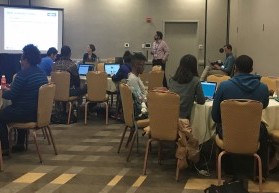 The recent Tapia Conference on Diversity in Computing in Atlanta brought together some 1,200 undergraduate and graduate students, faculty, researchers and professionals in computing from diverse backgrounds and ethnicities to learn from leading thinkers, present innovative ideas and network with peers.
The recent Tapia Conference on Diversity in Computing in Atlanta brought together some 1,200 undergraduate and graduate students, faculty, researchers and professionals in computing from diverse backgrounds and ethnicities to learn from leading thinkers, present innovative ideas and network with peers.
The Tapia conference—named for Richard Tapia, a professor at Rice University who is recognized as a national leader in diversity—was established in 2001 to provide an engaging, exciting and intimate environment to recruit top diverse technical talent and highlight career paths in industry, academia and government. Over the years the conference has grown to include invited speakers, sessions, workshops, birds-of-a-feather panels and student posters addressing the latest trends in diversity, inclusion and participation in the computing field.
Statistics from the 2017 conference:
- 150+ college/universities represented
- 60% students
- 30+ ethnic backgrounds
- 3.5 average GPA of Scholarship Recipients
- 650 resumes in the Tapia Database
In addition to academia and industry, there was a prominent presence from the Department of Energy’s national labs: Argonne, Brookhaven, Lawrence Berkeley, Lawrence Livermore, Los Alamos, Oak Ridge and Pacific Northwest. Elizabeth Bautista of Berkeley Lab and Tony Baylis of Livermore Lab devised a conference floor logistics strategy for lab attendees to enable maximum career fair traffic and facilitated hosting and judging of the ACM Student Research Competition and Poster session.

NERSC staff Debbie Bard, Brian Friesen and Mario Melaro led a hands-on KNL workshop during HPC Day at the Tapia conference.
This year’s conference again featured “HPC Day,” comprising three Lab-led workshops showcasing technologies such as fast, large data transfers (Los Alamos), GPU computing (Oak Ridge) and KNL (Knights Landing) computing (NERSC). The KNL workshop, presented by NERSC staff Debbie Bard, Brian Friesen and Mario Melara, included a hands-on tutorial that focused on the NERSC Cori KNL system (available compute nodes, file systems, runtime environment and batch environment). Attendees were also given the opportunity to build and run a simple application and then optimize it.
“The interactive sessions during the three workshops gave the 100 participants the opportunity to experience and learn from immersive, hands-on learning experiences,” said Bautista, who also participated in a panel called “Grassroots Mentoring: Creating Communities to Succeed in Technology.” “The 22 KNL participants who learned about the architecture, burst buffer and how to optimize test programs were excited when each of their codes had a ‘speed up,’ and they were even awarded medals for their efforts.”
Participation in these type of events highlight the science made possible at national labs as well as the diverse careers that are available in these organizations, Bautista added. “This is another way to widen diversity in our current and future workforce and recruit diverse students and post-docs; as we seek innovation, creativity and propagation of elegant ideas, we’ll achieve the highest measurable outcomes from diverse perspectives, experiences and people,” she said.
Source: NERSC



